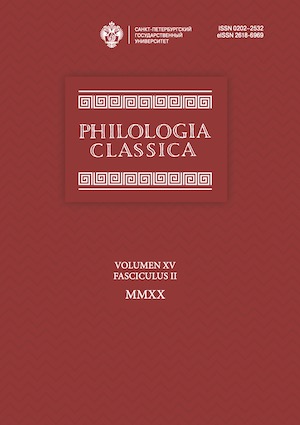Latin Case System: Towards a Motivated Paradigmatic Structure
DOI:
https://doi.org/10.21638/spbu20.2020.203Аннотация
The article attempts, firstly, to critically analyze the traditional order of cases in Latin, secondly, to discover an internal mechanism that brings the elements of a paradigm together, and thirdly, to present a new model of the nominal and pronominal case paradigms in Latin. The authors develop the idea that the crucial role in structuring a case paradigm belongs to morphemic syncretism. The syncretism is treated as a systemic phenomenon of morpheme neutralization rather than a result of phonetic reduction. In the paradigm built on this principle, the cases marked with the same endings necessarily take adjacent positions. There is a certain correlation between the morphemic syncretism and the semantics of cases extensively exemplified in the Latin literature. Taking this as reference point, the authors establish a formally motivated paradigmatic order of cases and single out a set of semantic features that shape the case paradigm. This method enables authors to find the non-contradictory paradigmatic positions for both the core and the “marginal” cases (vocative and locative). Applied to the pronominal cases, however, it reveals the significant discrepancy between the nominal and pronominal paradigms concerning two cases — nominative and genitive. The pronominal nominative’s special status is determined by its pragmatic rather than syntactic functions, which is typical for pro-drop languages. The genitive case appears in three different forms that originate from the possessive pronouns and correspond to the three basic functions of the genitive — possessive, objective, and partitive ones. Such transparadigmatic syncretism brings together the paradigms of personal and possessive pronouns, which are related by nature. The approach suggested in this study makes it possible to present in a new way the nominal and pronominal case paradigms, to demonstrate in what points they differ from each other, and to highlight some functional and semantic features of the particular cases.
Ключевые слова:
Latin, case paradigm, nominal and pronominal cases, syncretism, morphemic neutralizations, paradigmatic oppositions
Скачивания
Библиографические ссылки
Zheltov A. Ju., Zheltova E. V. Why the language saves on the case forms, or about the order of cases in Latin. Indoeuropean Linguistics and Classical Philology 2020, 24, 1040–1069. (In Russian)
Загрузки
Опубликован
Как цитировать
Выпуск
Раздел
Лицензия
Статьи журнала «Philologia Classica» находятся в открытом доступе и распространяются в соответствии с условиями Лицензионного Договора с Санкт-Петербургским государственным университетом, который бесплатно предоставляет авторам неограниченное распространение и самостоятельное архивирование.






